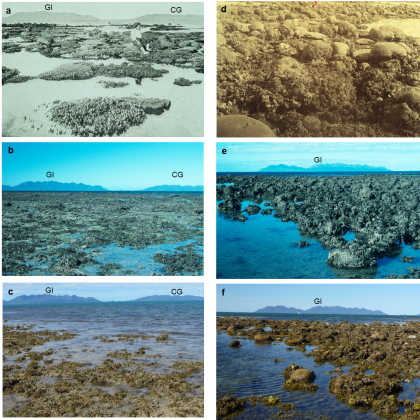
The timing of significant Great Barrier Reef coral loss captured by a series of historical photos has been accurately determined for the first time by a University of Queensland-led study.
Professor Jian-xin Zhao from UQ’s School of Earth Sciences said the photos were a powerful visual tool used to highlight the recent decline of the Great Barrier Reef.
“These photographs taken from the late 19th Century onwards of two inshore Great Barrier Reef locations near Bowen, Queensland, reveal a dramatic loss of coral cover,” Professor Zhao said.
“Yet until now no information has been available on when these changes took place, or what caused these changes – which can lead to the photos being misinterpreted.”
Using techniques including uranium-thorium dating in UQ’s Radiogenic Isotope Laboratory researchers were able to determine when the corals had died with a precision of up to one to two years.
“Without the exact timing, the reasons for the loss depicted in the historical photos would have remained speculative,”
“This technology allows us to link the coral loss to specific physical events.”
Dr Tara Clark from the School of Earth Sciences said an integrated approach was essential to understanding past ecological changes on coral reefs before modern-day monitoring programs began.
“It’s important to reliably assess the current state of these reefs and whether they are indeed undergoing a decline as a result of human influences,” she said.
“For Bramston Reef, our results revealed that mortality was more recent than previously thought, coinciding with a big flood event and extreme low tide in 1990-1991 – but showed some recovery by 2012.
“Just two kilometres away, Stone Island has shown very little change since n similar events wiped it out in 1918.
“The impact of this earlier event was described as though a huge razor had shaved off all the coral growth and it is still like this today. The reasons why remain speculative and require further investigation.
“For Stone Island, which shows little evidence of recovery, any future disturbances may further hinder its ability to bounce back.”
These findings provide a valuable benchmark for managers to be able to continue monitoring the recovery (or lack thereof) of these reefs.
The study, published in Scientific Reports, was conducted by scientists from UQ, James Cook University, and the Great Barrier Reef Marine Park Authority.
UQ scientists involved included Professor John Pandolfi of the School of Biological Sciences, research officer Dr Ai Duc Nguyen of the School of Earth Sciences and PhD students Nicole Leonard and Hannah Markham.
It was supported by a National Environmental Research Program Tropical Ecosystems Hub Project grant and an Australian Research Council Linkage, Infrastructure, Equipment and Facilities grant.
Dr Clark said the researchers were seeking funding to allow other reef locations to be studied.
Media: Dr Tara Clark, t.clark1@uq.edu.au, +61 7 3346 9755; Professor Jian-xin Zhao, j.zhao@uq.edu.au, +61 410 683 866.
.jpg)










